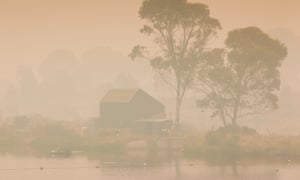The swamp near my home has been dry for two years, and fires burn down to the beaches
Last Australian autumn, and all through winter, a group of retired fire chiefs wanted to meet with prime minister Scott Morrison,
and warn him that Australia had passed, as if through a gate, to a new
level of combustibility, and that the fire peril for the coming summer
would be unprecedented in length and ferocity. For fear that the group
might link this menace with the forbidden term “climate change”, the
leader Australians now call “Scotty from marketing” refused to meet
them, though in good faith they kept on trying to arrange a session with
him into the spring. As they pointed out, Morrison took considerably
less time before meeting church leaders who wanted to be exempt from
anti-discrimination laws involving the employment of gay staff and
similar “freedom of religion” matters. The fire chiefs worried that we
share our combustibility with the Pacific coast of the United States,
and that given the overlapping North American and Australian fire
seasons, the hiring of air tankers was going to get more and more
difficult. Above all, they were concerned that this summer’s fires would
take on a new scale and not surrender to normal firefighting. They felt
they had begun to see abnormal symptoms in the 1990s.
Once we got over our colonial Eurocentrism and realised that the Australian bush was not going to go to any trouble to imitate European flora, we began to take a perverse pride in the fact that so many of our plants are germinated by fire: “phoenix plants”. We know now that our species has been in Australia so long, for tens of millennia, that Indigenous Australians learned fire-stick farming – regenerating the continent with skilfully lit fires, which also had the benefit of flushing protein-rich marsupials out into the open. The reality is that swathes of Australia must burn for its own good. Les Murray, the late, great poet, said Australia had only two seasons: drought, of which fires were symptomatic, and flood.
Both sides of the country, east and west, have had calamitous drought and fires in their time. But the drying out to which Australia has been subjected in this last year is unprecedented and seems to most people to proclaim climate crisis. The denialists are making a last stand by accusing the Greens of preventing back-burning in national parks; and of course the Murdoch press embraces that proposition and emphasises cases of arson. The fact that there are cases of arson, and always have been in Australia and California, explains a minority of blazes, but it does not explain the voracity and appetite of these flames. On the right wing of the coalition that governs Australia, and which Morrison needs if he is to govern, sturdy climate denial remains undented. Yet the climate crisis has for the first time replaced the economy as the nation’s chief political issue, for the very question of the habitability of Australia now stares us in the face. On 4 January, an outer suburb of Sydney – Penrith, below the Blue Mountains that were burning at the time – achieved the highest temperature on Earth that day, 48.9C. Sydney suburbs, as hot as they can be in summer, have never achieved such Saharan heights before.

Once we got over our colonial Eurocentrism and realised that the Australian bush was not going to go to any trouble to imitate European flora, we began to take a perverse pride in the fact that so many of our plants are germinated by fire: “phoenix plants”. We know now that our species has been in Australia so long, for tens of millennia, that Indigenous Australians learned fire-stick farming – regenerating the continent with skilfully lit fires, which also had the benefit of flushing protein-rich marsupials out into the open. The reality is that swathes of Australia must burn for its own good. Les Murray, the late, great poet, said Australia had only two seasons: drought, of which fires were symptomatic, and flood.
Both sides of the country, east and west, have had calamitous drought and fires in their time. But the drying out to which Australia has been subjected in this last year is unprecedented and seems to most people to proclaim climate crisis. The denialists are making a last stand by accusing the Greens of preventing back-burning in national parks; and of course the Murdoch press embraces that proposition and emphasises cases of arson. The fact that there are cases of arson, and always have been in Australia and California, explains a minority of blazes, but it does not explain the voracity and appetite of these flames. On the right wing of the coalition that governs Australia, and which Morrison needs if he is to govern, sturdy climate denial remains undented. Yet the climate crisis has for the first time replaced the economy as the nation’s chief political issue, for the very question of the habitability of Australia now stares us in the face. On 4 January, an outer suburb of Sydney – Penrith, below the Blue Mountains that were burning at the time – achieved the highest temperature on Earth that day, 48.9C. Sydney suburbs, as hot as they can be in summer, have never achieved such Saharan heights before.

"The New South Wales coast is a place of childhood vacations and dreams, with beaches that stretch for miles"
I am lucky enough to live next to a national park, and when I first moved here there was a hanging swamp on top of the vast sandstone block of North Head. This was a swamp that in most seasons had water in it, though it would occasionally dry out for short periods. It was the home of a number of species of frog. It was visited by ducks and other water birds, and by a handsome lizard called the water dragon, which enjoyed eating the tiger moths that lived there. That swamp has been dry for two years. Drying out has happened all along the coast, and we have had the extraordinary spectacle of fires burning down to the fringe of beaches, and populations taken off the coast by warship.
The New South Wales coast is a place of childhood vacations and dreams, with atmospheric paperbark swamps running behind beaches that stretch for miles. The lagoons and swamps were perpetually too moist to burn. Fires burning down to the coast is, to use the catchphrase, the new normal. The coast and its valleys and beaches have been places where great numbers of nature lovers, retirees and escapees from the city have chosen to settle. The coast north and south of Sydney is a dream every city dweller has entertained, a migration always on the cards for us. Now an exceptional vulnerability has overtaken regions where people previously lived securely in the bush. The Keneallys’ chosen town on immigration – Kempsey, New South Wales – has for the first time since settlement been ringed by fire. Its long, exquisite river, the Macleay, has become tainted with so much ash that fish have died. Even rainforest has become combustible.
Recently, on a walk in the bush, I encountered one of the species threatened, by the fires and the state of the world, with extinction. It is one of the two survivors from the ancient supercontinent of Gondwanaland: the echidna, a spiny anteater that both lays an egg and suckles its young in the comfort of its burrow. I love this creature: it gives off an air, despite its limited movement, of industry, and she was turning over the earth to the depth of her beak in her search for provender. It was touching to see this most enduring of animals at its ancient earthwork, unchallenged by fire here, unlike in other forests. It speaks to how much human occupation, a tower of millennia, there has been in Australia, and of the contrast between its Indigenous stewards and the stewardship of us immigrant groups. It had taken us less than two and a half centuries to bring the 50m-year-surviving echidna, and the system sustaining it, to crisis.

These fires have not been a straw in the wind. They have been brutally manifest and undeniable in the force of their argument. They have the power to change politics here and in other places, as long as they are read honestly. After our long glorying in minerals, it is promised that, if it wishes, Australia can be a leader in the new post-fossil-fuel world. It is a destiny our politicians seem unwilling to embrace, but they may have to.
For the fires have changed us. Perhaps we, too, need fire to germinate an essential concept.
• Thomas Keneally is the author of more than 30 novels, including Schindler’s Ark, which won the Booker prize in 1982
This article has details on how to help with the Australian relief effort.
If you would like your comment on this piece to be considered for Weekend magazine’s letters page, please email weekend@theguardian.com, including your name and address (not for publication).

Thank you Thomas Keneally...for showing that we must embrace the lessons of this extraordinary summer or the suffering, already great, will be incalcuable!For the planet as well as for our country!
ReplyDelete